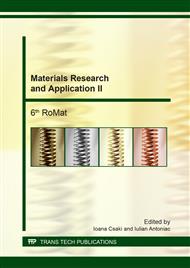[1]
Y.Q. Jiao, Y.H. Wen, N. Li, J.Q. He, J. Teng, Effect of solution treatment on damping capacity and shape memory effect of a CuAlMn , Journal of Alloys and Compounds 491, (2010) 627-630.
DOI: 10.1016/j.jallcom.2009.11.026
Google Scholar
[2]
N. Cimpoeşu, S. Stanciu, M. Meyer, I. Ioniţă, R. Cimpoeşu Hanu, Effect of stress on damping capacity of a shape memory alloy CuZnAl, Journal of Optoelectronics and Advanced Materials, 12 (2010) 386-391.
Google Scholar
[3]
M. -A. Paun, R. Cimpoesu Hanu, N. Cimpoesu, M. Agop, C. Baciu, S. Stratulat, C. Nejneru, Internal friction phenomena at polymeric and metallic shape memory materials. Experimental and theoretical results, Materiale Plastice 47 (2010) 209-214.
Google Scholar
[4]
A.G. Shivasiddaramaiah, U.S. Mallik, L. Shivaramu, S. Prashantha, Evaluation of shape memory effect and damping characteristics of Cu–Al–Be–Mn shape memory alloys, Perspectives in Science 8 (2016) 244-246.
DOI: 10.1016/j.pisc.2016.04.041
Google Scholar
[5]
S. Montecinos, Influence of microstructural parameters on damping capacity in CuAlBe shape memory alloys, Materials & Design, 68 (2015) 215-220.
DOI: 10.1016/j.matdes.2014.12.034
Google Scholar
[6]
Y. Sutou, T. Omori, N. Koeda, R. Kainuma, Effects of grain size and texture on damping properties of Cu-Al-Mn-based shape memory alloys, Materials Science and Engineering A. 438-440 (2006)743-746.
DOI: 10.1016/j.msea.2006.02.085
Google Scholar
[7]
J. San Juan, M. L. Nó, Damping behavior during martensitic transformation in shape memory alloys, Journal of Alloys and Compounds 355 (2003), 65-71.
DOI: 10.1016/s0925-8388(03)00277-9
Google Scholar
[8]
A.G. Shivasiddaramaiah, U.S. Mallik, L. Shivaramu, S. Prashantha, Evaluation of shape memory effect and damping characteristics of Cu–Al–Be–Mn shape memory alloys, Perspectives in Science 8 (2016) 244-246.
DOI: 10.1016/j.pisc.2016.04.041
Google Scholar
[9]
J.P. Oliveira, Z. Zeng, T. Omori, N. Zhou, R.M. Miranda, F.M. Braz Fernandes, Improvement of damping properties in laser processed superelastic Cu-Al-Mn shape memory alloys, Materials & Design 98 (2016) 280-284.
DOI: 10.1016/j.matdes.2016.03.032
Google Scholar
[10]
H. Yin, Y. Yan, Y. Huo, Q. Sun, Rate dependent damping of single crystal CuAlNi shape memory alloy, Materials Letters 109 (2013), 287-290.
DOI: 10.1016/j.matlet.2013.07.062
Google Scholar
[11]
D.A. Porter and K. E. Easterling, Phase Transformations in Metals and Alloys, Chapman and Hall, London (1990), 364.
Google Scholar
[12]
G. Z. Zatulski, M. A. Kravchenko, V. K. Larin, A. M. Firsov, Met. Sci and Heat. Treat. 33, (1991), 861.
Google Scholar
[13]
D. Delpueyo, X. Balandraud, M. Grediac, S. Stanciu, N. Cimpoesu, Measurement of Mechanical Dissipation in SMAs by Infrared Thermography, Residual Stress, Thermomechanics & Infrared Imaging, Hybrid Techniques And Inverse Problems, VOL 9, (2017).
DOI: 10.1007/978-3-319-42255-8_2
Google Scholar
[14]
N. Cimpoesu, S. Stanciu, D. Tesloianu, R. Cimpoesu, R. F. Popa, and E. Moraru, A study of the damping capacity of mechanically processed cu – 9. 2Al – 5. 3Mn – 0. 6Fe shape memory alloys, Metal Science and Heat Treatment, 58, Nos. 11 – 12 , (2017).
DOI: 10.1007/s11041-017-0086-0
Google Scholar


